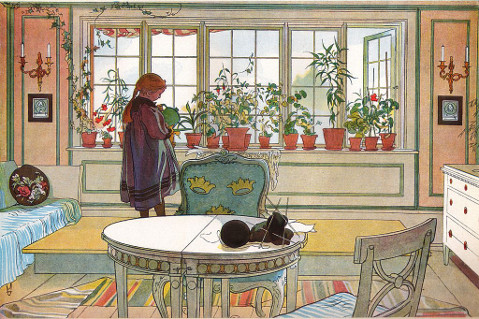Green View
A Window of Plants for the Drought

The formerly green lawns are brown expanses, and the water guzzlers in the garden have been reduced to wilted hulks if not truly crispy silhouettes of their former selves. The view out the windows of the house is dreary to say the least. Pockets of green may have been preserved, especially for those gardeners who have been transitioning to drought-adapted plants. But the lush life is past, at least for now.
One way to brighten the mood is to select a few green partners to grow indoors. The benefits are many, and they can thrive on that cool water from the taps of the sink or tub, usually wasted, as the warm water for dishwashing or showering finally makes it all the way from the water heater. The vibrant foliage is not only soothing and softening but also scrubs the air and provide some additional oxygen to the air column. Some, like the common spider plant (Chlorophytum comosum), can even remove household chemicals like chloroform. Here are some tricks for success in moving a little bit of nature to your interior space.
Of the three things — light, water, and nutrients — that plants need, light is the most important one to plan for when growing indoors. While there are a few tough foliage plants that thrive on neglect in dark, dingy corners, most need moderate to bright light to do well. And houseplants that provide cheery flowers usually require as bright a space as possible, say in front of a south- or west-facing window. Watch out for scorching if the exposure is too extreme. Windowsills and plant stands placed in front of the window are the best places to put plants to them keep healthy and happy. It is possible to put a fern or a ficus, a bromeliad or an orchid in a dim position away from the window to showcase it for a while, but remember to rotate it back to its brighter spot for long enough to keep it vigorous. If the stems start stretching out and the leaves look pale and thin, it’s past time to give it a break.
Many of the plants sold in nurseries and home improvement centers as house plants are tropical or subtropical in origin. Their water requirements may be high, but having them contained makes it easy to monitor the soil moisture and dole out just the right amount without wasting any. Moist is good, soggy is probably not, nor is completely drying between watering (succulent plants are the major exceptions to this last rule). Some would like higher humidity (the moisture content of the air itself), too, so a brief visit to the shower (in all that steam left behind) or a sprinkle on the foliage now and then can help keep them fully hydrated.
Even the best care may leave a houseplant a little stressed out and susceptible to pest attack. The usual culprits are aphids, mealy bugs, scale, and spider mites. Luckily, all of them can be controlled with judicious washing. If ants have set up housekeeping in the pots, it’s best to control them with ant bait.
The garden outdoors may seem like a disaster, but a few green spots indoors can ease the pain.



